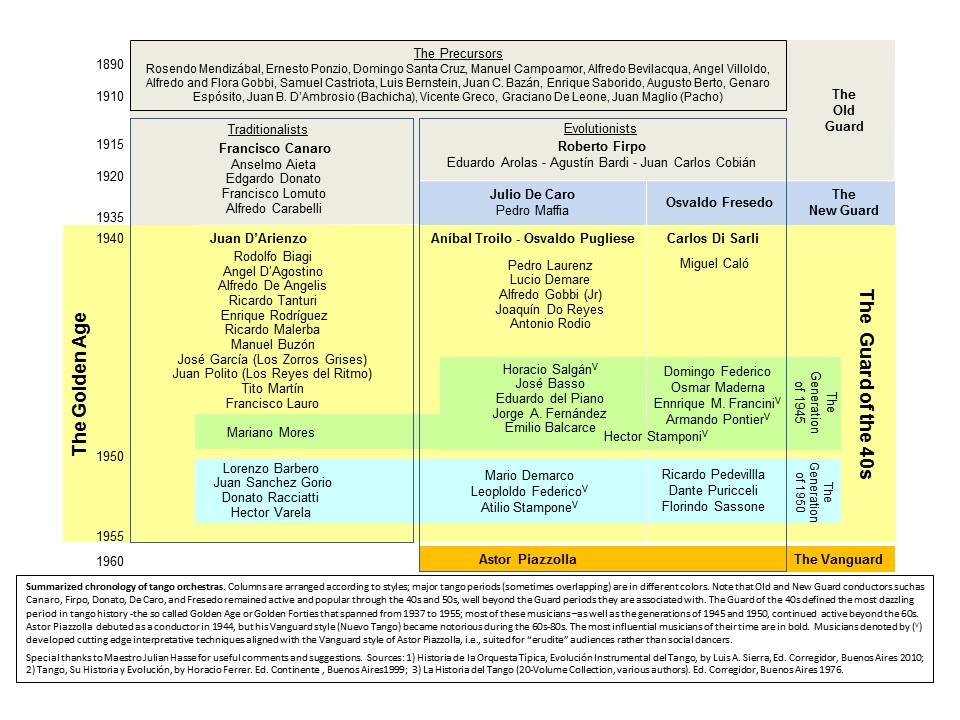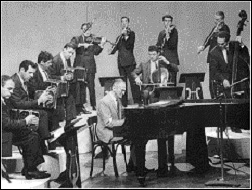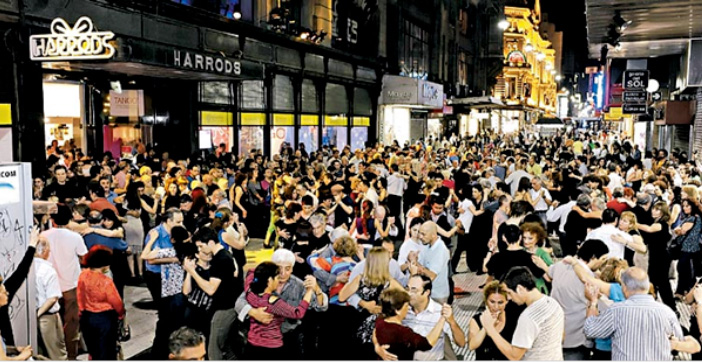Major Tango Orchestras by Eduardo Lazarowski

Argentine Tango, its origins and evolution
Tango is one of the most beautiful, elegant, and sensual dance of modern times. It has its origins in South America on both sides of the Rio de la Plata, whih separates the Argentinean province of Buenos Aires (and its city-port by the same name) from Uruguay and its capital Montevideo. By 1870-1880, waves of immigrants mainly from Italy, but also from Spain, England, and central-eastern Europe, arrived to the ports of Buenos Aires and Montevideo attracted by the prospect of jobs. Cultures and dialects mixed at the Sunday parties of the poor in the suburban neighborhoods, where waltzes, polkas, mazurkas, and habaneras blended with black candombes and gaucho’s tonadas. Tango was born as a dance and music of the lower class, but gradually metamorphosed into a sensual, elegant dance that conquered Buenos Aires society and the rest of the world.
The details of when, where, and how Tango happened are elusive. Technically speaking, tango was born around 1900, when well-structured compositions of a style definitively different from the habanera and other popular tunes were written for first time on the pentagram. Initially, tango was danced and played as a fast, happy, very rhythmic music that resembled that of marching bands, but by 1920-1925 the genre had adopted elements of erudite music, evolving into a polyphonic kind with multiple musical subjects, accentuated phrasing, complex rhythm, and a rich melody, as it is known today. A major event in this transformation was the incorporation of the bandoneón, a distant cousin of the accordion, into tango orchestras. With its lengthy and nostalgic phrasing, the bandoneón has become the soul of tango music.

Tango, the most relevant cultural phenomenon of the Argentinean society, had its golden époque during the so-called “the Decade of the Forties”. During this period, which actually expanded from the late 1930s to the mid-1950s, thousands of musicians in hundreds of orchestras embraced tango music, and millions of Argentineans poured onto the dance floors. Musicians such as Juan D’Arienzo, Carlos Di Sarli, Anibal Troilo, and Osvaldo Pugliese were celebrities of the highest imaginable popularity. Just the announcement of any of these names was enough to fill out the biggest music halls; their soundtracks beat records of diffusion.
Economic and political factors along with the surge of rock and roll music in the 1950s gradually displaced tango music from its privileged place in the mind of Argentineans, but the tunes of the golden époque remained alive in their souls, subtlety passing to the new generations. Astor Piazzolla genially fused tango with erudite chamber music and jazz. His New Tango privileged the music over the dance and, while resisted by traditionalists, conquered new audiences worldwide. Piazzolla’s popularity together with the success of “Tango Argentino” and other majestically choreographed presentations of tango dance companies in Europe, Japan, and the U.S. contributed greatly to the renascence of tango traditions and opened the door to the return of tango as a social dance in the 1990s.
Today, Tango is danced again not only in countless “milongas” (dance floors dedicated to tango music) in Buenos Aires, but all over the world. In 2009, tango dance was declared Cultural Patrimony of the Humanity by UNESCO, the United Nations Educational, Scientific, and Cultural Organization.
The tango embrace is a unique element that distinguishes tango from other popular dances, most of which are danced by partners that move separately from each other. The embrace also defines the two major styles of Argentinean tango dance: the “salon” style is danced in relatively close but not strictly tight embrace; and the “milonguero” style, which is danced tightly embraced to allow couples to navigate in crowded floors. Irrespective of differences in the embrace and figures of embellishment associated with these styles, the most important features that tango dancers care about are sentiment and elegance.
Argentine tango has a significant presence in the Triangle area. We have a vibrant community that has been strong for several years.
Take a moment to watch these videos (see links below) showing world renowned Argentinean tango dancers of different styles, who are friends and frequent visitors of our local community.

Links to videos by Argentine tango maestros:
Alicia Pons (Milonguero style)
http://www.youtube.com/watch?v=oIBNLMgk9r0
Lorena Ermocida (Salón style)
http://www.youtube.com/watch?v=YPqpOU_Ov7M
Oscar Casas and Ana Miguel
https://www.youtube.com/watch?v=_0yQa7FY7yM
Guillermo Merlo and Fernanda Ghi (Salón style)
http://www.youtube.com/watch?v=0qA2GoLqafo
